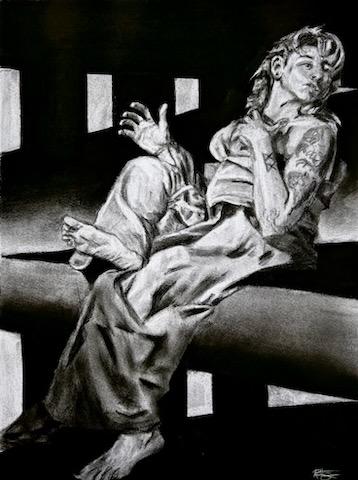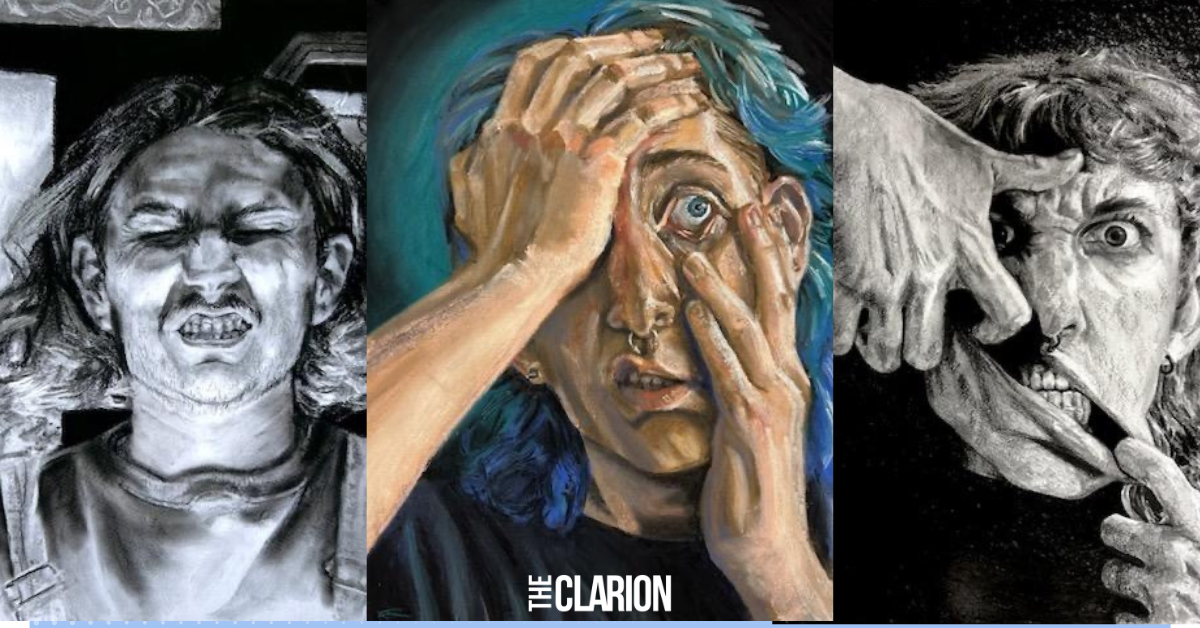Some of the most exceptional journeys are memorable because of how relatable they are. In the case of Alexander Rothery, Art Major extraordinaire, few have tales the majority of Sinclair’s student body can connect to. Where it differs, veers off from the norm, is why Rothery has quickly become an artist people in Ohio and beyond will want to keep an eye out for.
Today he’s won scholarships, is preparing for dream trip to Japan as part of a study abroad program and continues to earn praise from his professors. And its all thanks to his pursuit of a passion that’s been with him his whole life.
“There was a point last semester where I had a bunch of things to apply for and work on,” he said in an interview with The Clarion.
“Things just started to roll in. I won the Spring Scholarship, was accepted for the study abroad trip to Japan, and was producing a constant stream of art in three studio classes. Working so hard and getting that payoff for pursuing my art career was massive. The biggest thing, however, was having such a supportive environment full of professors helping me thrive,” Rothery added.
He’s come a long way from his days drawing during 15-minute breaks as a manager at Chipotle. But while the road to where he is now has been far from easy it has certainly helped him reach the level he’s at now.
“I feel like I’ve always been drawn towards art at least as early as I can remember. It doesn’t really feel like a thing that started, it’s just kind of always been,” the Daytonian said.

Like many kids growing up in the 2000s, Rothery was exposed to a wide variety of art through TV. That included cartoons and the first major Shounen animes to go mainstream in the US. He wanted to create what he saw and as early as Elementary School was part of his own group of burgeoning artists.
“At that age we were just doing it for fun. Growing up, I sensed it was not something I could pursue as a career. It was intimated that if I tried to be an artist I’d have to go art school and that art school wasn’t a viable option. Then there was the idea that it didn’t lead to a career that paid off art school.”
That didn’t stop him from drawing every chance he could get. Rothery, like any Manga fan of taste, found himself gravitating towards the work of the late Kentaro Miura and Junji Ito. Moving out aged just 18, he began working for Chipotle in Columbus. Despite art school still not seeming plausible Rothery still drew. A collision between his passion and job would pave the way for him to head to Sinclair.
“It started with hating my job. I was just overworked really badly and was even injured a few times. Once I got a really bad staph infection in my right hand and had to face the reality that I might need to have three fingers amputated and would never draw again. In a way it was kind of poetic.”
A particularly bad supervisor was the straw that broke the camel’s back for Rothery. Just a year before leaving the conventional life he’d built behind, Rothery would attempt his first abstract work, and hasn’t looked back since.
“I feel like that experience kind of led me to make this one painting that felt a lot deeper and a lot more personal as well as symbolic compared to the small but detailed drawings I’d been doing before. Having the motivation and inspiration to make a piece based on how I was feeling and enjoying that so much really led me to try to pursue this path,” he said.
It was far from easy. For years Rothery was used to drawing with a pencil on small sketch pads. He had to move away from line drawing, learn new techniques, and embrace new mediums.
“I definitely was not looking at enough art. That was the first thing. I was very isolated to the styles and art that I liked,” he said in reference to the challenges he faced as a first year art major.
“But coming to art school it was like ‘look at this Still Life, look at this Matisse, look at all these things you would normally never look at, appreciate, and would probably scoff at’. So it was definitely important to keep an open mind.”
Since then, the progress he’s made has been nothing short of tremendous.
“I rarely use line. I’ve almost completely abandoned it because I just enjoy finding shape so much and not having to be so meticulous and being able to express myself a lot quicker and more authentically. That change is really a result of the art I look at and how I approach things.”
“I’m always thinking about art, compositions, colors, and ideas on how I can make them all come together into something I’d like to create. At times its almost stream of consciousness for me.”
His preparations start on a typical car ride home after class. It’s usually a 30-minute trip that he uses to zone out and confront the parameters of whatever assignment he has to do.
“How can I express what I’m feeling in this moment with the conflict or joy that I’m having? How can I translate that into a composition that is pleasing, not too straightforward, and doesn’t have a lot of generic elements?”
Next comes the preparation process, which Rothery finds calming. Selecting his paper, taping it down, and choosing what pastels he’ll use brings an almost ritualistic tranquility to the artist. It sets the stage for the frenzied creation of his basic layout.
“Usually after that I walk away and think a little more. I’ll do a couple of other sessions, drawing until I don’t feel like drawing anymore. I’ll come back to it until I feel its done,” said Rothery.
An important part of his art process is music. It helps break the tedium of long hours working and reworkings aspects of a painting. Instead distracting him, Rothery finds that music helps tame his own sense of anxiousness and self-criticism.
“I tend to have a racing mind so I often need things to calm those thoughts down while the other part of my brain makes art. But I also feel the tone and expression of music can help develop the tone of painting. How I feel determines what genres I listen to and how fast I work, how my artistic expression moves with the rhythm.”
Rothery’s playlist is almost as varied as his artistic inspirations. Soul Scream, Japanese City Pop, MF Doom, Mac DeMarco, indie rock, and just about everything in between. He’s a bit broader in terms of his own creative fuel. Every piece has its own inspiration from the challenges of being queer in today’s environment to Hokusai and Hiroshige.
“These days I’ve gravitated towards artists like Francis Bacon, Aleksander Rostov, and a move away from representation towards ambiguous art that’s open to interpretation. I want viewers to find their own meaning in how I express myself. Because I don’t like art that straight up tells people how they’re supposed to feel. I really like people being able to look and develop their own connections with what I create.”
Most importantly, however, has been Rothery’s free spirit. It’s what allowed him to defy those voices that warned him against a career in art and chart his own path to success.
“As a queer person, I have this natural inclination to do what makes me happy instead of following what others tell me. Life experiences have also driven me to be more free spirited. I tried to live a life that was what most would consider by the book and realized that it wasn’t for me. That’s what led me here,” said Rothery.
Its certainly paid off. Now members of his family are showing just how proud they are of his work and he’s excitedly preparing for his first trip to Japan in May. Following his dreams has certainly opened tons of doors for the art major.
“Of course, I’d like to have exhibitions one day. I would love to become an illustrator as its what I’m drawn towards and been influenced by most of my life. Overall, I’d like to transfer either to an actual art school or somewhere that has a more rigorous art program so that I can really nail down the things I need to learn still and if that fails just continue to teach myself beyond Sinclair,” said Rothery.
The innumerable skills he’s learned will serve Rothery well no matter where he ends up. Don’t be surprised if the painting maestro is Sinclair’s next best export. Just remember you heard it here first.
Written by Ismael David Mujahid, Executive Editor
(Featured Images from Alexander Rothery)
Check out our latest posts:
- More than a hobby: 3D Printing at Sinclair
 3D printing has only become a widely known concept in recent years. Since it has entered the zeitgeist, it has found many fans and contributors. The ability to make products in one’s own home with just a spool of plastic and a relatively small machine is a very tempting prospect. This accessibility makes 3D printing… Read more: More than a hobby: 3D Printing at Sinclair
3D printing has only become a widely known concept in recent years. Since it has entered the zeitgeist, it has found many fans and contributors. The ability to make products in one’s own home with just a spool of plastic and a relatively small machine is a very tempting prospect. This accessibility makes 3D printing… Read more: More than a hobby: 3D Printing at Sinclair - Listicle with The Clarion: Five Books to Read This Summer
 Once again, the semester will be ending soon. As much as being busy is stressful, summer tends to be boring without anything to do. Reading is an enjoyable and leisurely way to pass the time. Here are five books to read during summer break. “Parable of the Sower” – Octavia E. Butler It is a… Read more: Listicle with The Clarion: Five Books to Read This Summer
Once again, the semester will be ending soon. As much as being busy is stressful, summer tends to be boring without anything to do. Reading is an enjoyable and leisurely way to pass the time. Here are five books to read during summer break. “Parable of the Sower” – Octavia E. Butler It is a… Read more: Listicle with The Clarion: Five Books to Read This Summer - Double the Expertise: Siblings Advancing Education at Sinclair Community College
 Education runs in many families of those who attend Sinclair Community College. While it’s common for siblings to attend the same college as students, siblings within the school’s faculty are a rare find. Here are two grand examples of siblings who work for Sinclair: Amy Gibson and Julie Trice One of Sinclair’s iconic sibling duos… Read more: Double the Expertise: Siblings Advancing Education at Sinclair Community College
Education runs in many families of those who attend Sinclair Community College. While it’s common for siblings to attend the same college as students, siblings within the school’s faculty are a rare find. Here are two grand examples of siblings who work for Sinclair: Amy Gibson and Julie Trice One of Sinclair’s iconic sibling duos… Read more: Double the Expertise: Siblings Advancing Education at Sinclair Community College - Correction: Dayton NATO Story in April Print Edition Amended
 In the “Dayton Braces for NATO” article of the The Clarion’s April print edition it was stated that President Donald Trump was expected to attend the upcoming NATO assembly. It should have said that Donald J Trump was invited to participate in the assembly according to Jason Galanes, chief of staff for Congressman Mike Turner,… Read more: Correction: Dayton NATO Story in April Print Edition Amended
In the “Dayton Braces for NATO” article of the The Clarion’s April print edition it was stated that President Donald Trump was expected to attend the upcoming NATO assembly. It should have said that Donald J Trump was invited to participate in the assembly according to Jason Galanes, chief of staff for Congressman Mike Turner,… Read more: Correction: Dayton NATO Story in April Print Edition Amended - Inside the Most Competitive NBA Playoffs in Years
 Now that the regular season is in the books, fans are thrilled for the playoffs. The 2025 NBA playoffs keep fans excited and looking forward to the intense matchups, breakout performances and plenty of head-to-head rivalries as 16 teams begin their quest for a championship ring. The 2024 champions in the Eastern Conference are the… Read more: Inside the Most Competitive NBA Playoffs in Years
Now that the regular season is in the books, fans are thrilled for the playoffs. The 2025 NBA playoffs keep fans excited and looking forward to the intense matchups, breakout performances and plenty of head-to-head rivalries as 16 teams begin their quest for a championship ring. The 2024 champions in the Eastern Conference are the… Read more: Inside the Most Competitive NBA Playoffs in Years


